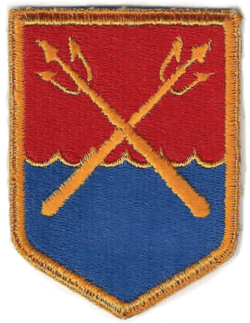Eastern Defense Command
| Eastern Defense Command | |
|---|---|
|
Eastern Defense Command Emblem | |
| Active | 1941–1946 |
| Country | United States of America |
| Branch | Army |
| Role | Home Defense & Training |
| Garrison/HQ | Fort Jay, Governors Island, New York |
Eastern Defense Command (EDC) was first established as the Northeast Defense Command on 17 March 1941 as one of four U.S. Army continental defense commands to plan and prepare and if need be, execute defense against enemy attack in the months before America's entry into World War II or as was defined: "a territorial agency with appropriate staff designed to coordinate or prepare to initiate the execution of all plans for the employment of Army Forces and installations against enemy action in that portion of the United States lying within the command boundaries."[1] This organization was charged with coordinating the defense of the Atlantic Coast, replacing the New England Defense Sector, an organization of U.S. First Army.
With the U.S. entry into World War II on December 8, 1941, the functions of the Northeast Defense Command was placed in a larger operational command, the Eastern Theater of Operations. following the example of the Western Theater of Operations established in the west coast but the original name was adopted once again on 20 March 1942[2]
The commanding generals of the defense commands were initially the commanders of the existing armies (First through Fourth). For the EDC, its first commander was Lieutenant General Hugh A. Drum, who concurrently commanded First U.S. Army. The command's headquarters was co-located with the existing First Army headquarters and a soon to be established Second Service Command Corps Area at Fort Jay, Governors Island in New York City. The command's operational region covered the states of Maine, New Hampshire, Vermont, Massachusetts, Rhode Island, Connecticut, New York, New Jersey, Pennsylvania, Delaware, Maryland, Virginia, North Carolina, South Carolina, Georgia and Florida (minus the western half of the Panhandle) as well as the District of Columbia.
Lieutenant General George Grunert assumed command of EDC upon Drum's mandatory retirement at age 64 in October 1943.
As prospects for any enemy attack on the United States all but diminished, Central Defense Command was merged into EDC on 15 January 1944. In early 1945, Southern Defense Command was also absorbed by EDC.
With Grunert's retirement in July 1945, his deputy, Brigadier General Kenneth Lord, became interim commander until the appointment of General Jonathan M. Wainwright. This was Wainwright's first command since he was compelled to surrender the Philippines to the Japanese Army in early 1942. In August 1945, he was liberated from a Japanese prisoner of war camp and assumed command after he returned to full duty. Upon Wainwright's 15 January 1946 transfer to Fourth Army at Fort Sam Houston, Lord assumed command until the abolition of Eastern Defense Command on 15 March 1946. Its residual staff and functions were transferred to 39th Headquarters and Headquarters Detachment, Special Troops, First Army as it returned from it combat assignment in Europe and its initial state-side posting at Fort Bragg, North Carolina.
Commanders
The following men served as Commanding General, Eastern Defense Command:
- Lieutenant General Hugh A. Drum, 18 March 1941 – 8 October 1943
- Lieutenant General George Grunert, 8 October 1943 – 31 July 1945
- Brigadier General Kenneth P. Lord, (acting) 1 August 1945 – September 1945
- Lieutenant General Jonathan M. Wainwright, September 1945 - January 1946
- Brigadier General Kenneth P. Lord, January 1946 – 15 March 1946
See also
- Western Defense Command
- Central Defense Command
- Southern Defense Command
- Alaska Defense Command
- Caribbean Defense Command
References
Conn, Stetson; Engelman, Rose C.; Fairchild, Byron (2000) [1964], Guarding the United States and its Outposts, United States in World War II, Washington, D.C.: Center of Military History, United States Army
